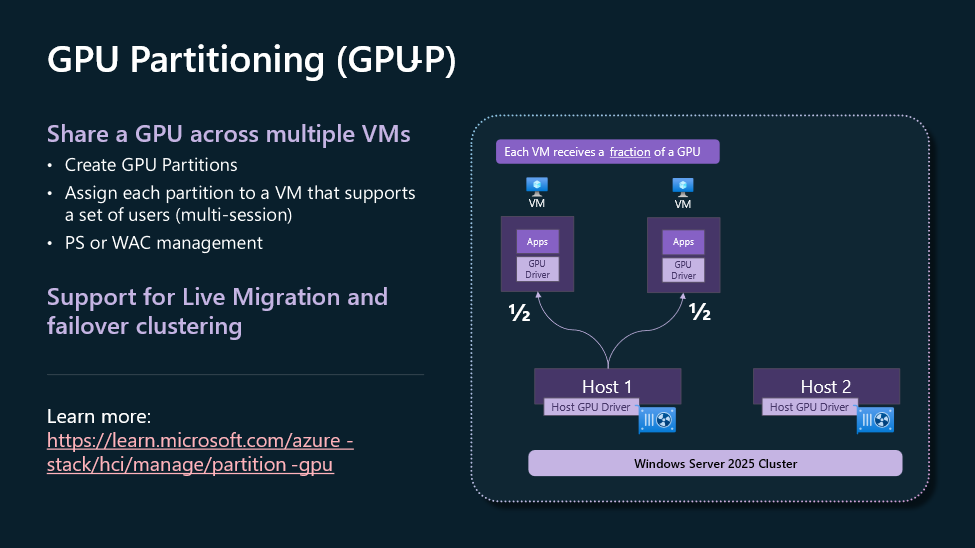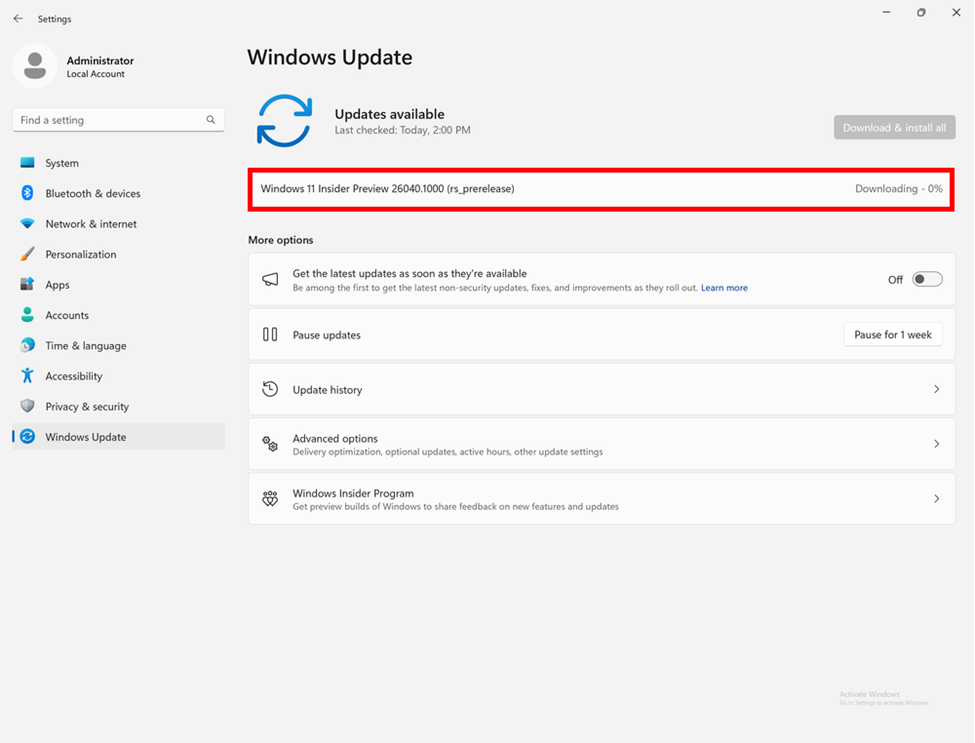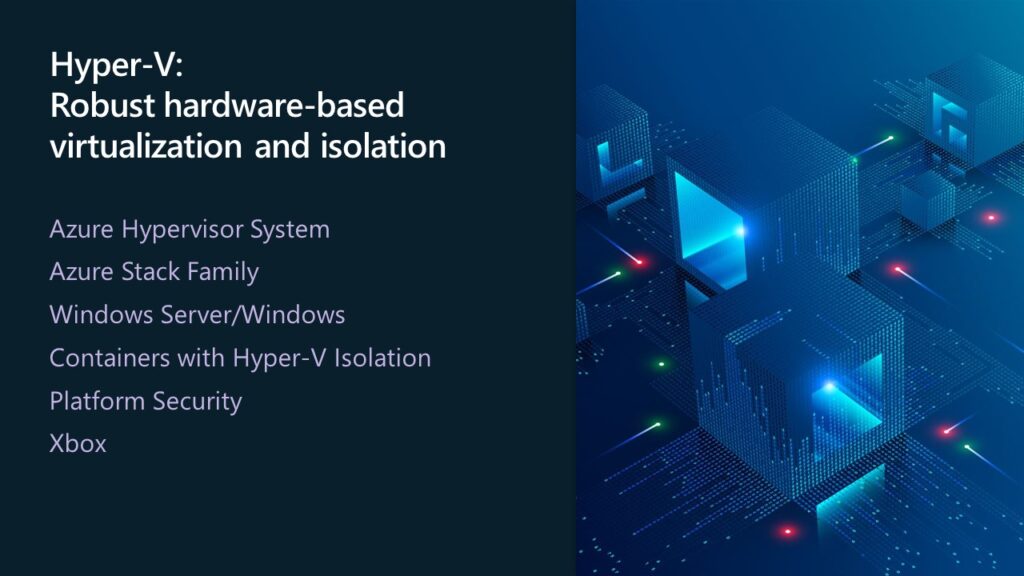Jeff Woolsey, Principal Program Manager for Azure Stack HCI & Windows Server, Microsoft
There have been several recent changes in the virtualization market, so this month, I wanted to take a moment to respond to the flood of questions we are receiving about Hyper-V futures, Windows Server 2025, and more. I surmise this blog will garner questions in the comments section, so I plan to answer those questions in the next blog. Let’s get started, beginning with Hyper-V itself.
Hyper-V is Microsoft’s hardware virtualization product. It lets you create and run a software version of a computer, called a virtual machine (VM). Each virtual machine acts like a complete computer, running an operating system and programs. When you need computing resources, virtual machines give you more flexibility, help save time and money, and are a more efficient way to use hardware than just running one operating system on physical hardware. This quick description is just the beginning of what Hyper-V delivers.
1/ Hyper-V is a strategic technology at Microsoft.
Please reread that last sentence. When I say strategic technology, I say this because Hyper-V is used throughout Microsoft in:
If you are using Windows Server, you already have Hyper-V. There is no additional charge, it’s built-in, just like it has been for over 15 years. The difference between Hyper-V in Windows Server Standard and Datacenter is the number of Windows Server guest OS instances that are included:
- With Windows Server Standard, you are licensed to run two instances of Windows Server guests OS environments.
- With Windows Server Datacenter, you are licensed to run unlimited copies of Windows Server guest OS environments.
- If you are running Linux as a guest OS, just make sure you are licensed by your distributor, and you can run as many Linux guests as you’d like to run on either Windows Server Standard or Datacenter.
In terms of Linux guest OS support, Hyper-V supports Red Hat Enterprise Linux, CentOS, Debian, Oracle Linux, SUSE, and Ubuntu. Linux integration services are included in the Linux kernel and updated for new releases. Hyper-V also supports FreeBSD with FreeBSD Integration Services built into FreeBSD 10.0 and later.
The unlimited use rights of Windows Server Datacenter coupled with the complete package of Hyper-V, software-defined storage (Storage Spaces Direct) and software-defined networking (SDN) deliver the best bang for your buck, making it extremely popular. Considering the power and scale of modern compute and storage (local, SAN, file, hyper-converged), Windows Server Datacenter is great for virtualization hosts.
2/ Hyper-V is used for more than just virtualization
Hyper-V is used for platform security. Virtualization-based security, or VBS, uses hardware virtualization and the hypervisor to create an isolated virtual environment that becomes the root of trust of the OS that assumes the kernel can be compromised. Windows uses this isolated environment to host several security solutions, providing them with increased protection from vulnerabilities and preventing the use of malicious exploits which attempt to defeat protections. VBS enforces restrictions to protect vital system and operating system resources, or to protect security assets such as authenticated user credentials.
Hyper-V is used for containers. Hyper-V isolation for containers offers enhanced security and broader compatibility between host and container versions. With Hyper-V isolation, multiple container instances run concurrently on a host; however, each container runs inside of a highly optimized virtual machine and effectively gets its own kernel. The presence of the virtual machine provides hardware-level isolation between each container as well as the container host.
3/ Hyper-V in Azure
Below is a screen shot of a virtual machine in Azure. Take a close look. This single VM supports up to 1,792 virtual processors and 29.7 terabytes of RAM. I apologize that this VM only has 29.7 terabytes of RAM (we support up to 48 TB of RAM), but those machines are busy running some of the largest workloads on the planet.

Because Hyper-V is used throughout Microsoft and in Azure, you reap the benefits of innovation we deliver in Azure that percolates through the other products. For example, today in Azure we have a wide range of VM offerings from small to gargantuan with a wide range of CPU, memory, networking, storage options and GPUs. Azure VMs with GPUs are available with single or fractional GPUs and designed for compute intensive, graphics intensive and visualization workloads from Virtual Desktops to AI. To enable these VM offerings in Azure with GPUs required changes to Hyper-V. Guess what is coming in Windows Server 2025?
4/ GPU Partitioning
Windows Server 2025 is introducing GPU partitioning (GPU-P) to enable scenarios on-premises or at the edge. You will be able to partition GPUs and assign them to VMs while retaining high availability and live migration. GPU-P is so flexible that you can live migrate VMs with partitioned GPUs between two standalone servers. No cluster required and great for test/dev!

5/ Windows Server 2025 is introducing Workgroup Clusters
Speaking of no cluster required, we are making significant changes to make Hyper-V deployments at the edge easier. One thing we are hearing from you is that due to the power of modern servers, it is easier than ever to deploy small footprints at the edge. Today, you can purchase two and three node clusters that are small enough to fit in the overhead compartment of an airplane. Up to Windows Server 2022, deploying a cluster requires Active Directory. While this is not an issue in the datacenter, this adds complexity at the edge. With Windows Server 2025, we are introducing the ability to deploy “Workgroup Clusters.” Workgroup clusters do not require AD and are a certificate-based solution!
Windows Server 2025 is chock full of innovation, and GPU-P and workgroup clusters are just the beginning. If you would like to learn more about Windows Server 2025 with demos, check out this Ignite session, “What’s New In Windows Server vNext (2025).”
6/ Windows Server 2025 Insider Preview: Now with Flighting!
If you want to start evaluating Windows Server 2025, there is no better time than right now and we’re making it easier than ever with Windows Server flighting! If you have a recent Windows Server insider build installed, you can now go to Windows Update in Settings, and check for updates. This will provide an update to a newer build, as a Feature update (also known as “in place OS upgrade”). That’s it! The process is easy and has proven well for hundreds of thousands of Windows 10 and Windows 11 insiders over the years.

7/ Windows Server 2025 Hyper-V
As I stated earlier, Hyper-V is a strategic technology at Microsoft used throughout our products. Since the first release of Hyper-V in Windows Server 2008, we never stopped innovating Hyper-V and there are no plans to stop.

This blog originally appeared on Microsoft.com and appears courtesy of Microsoft.